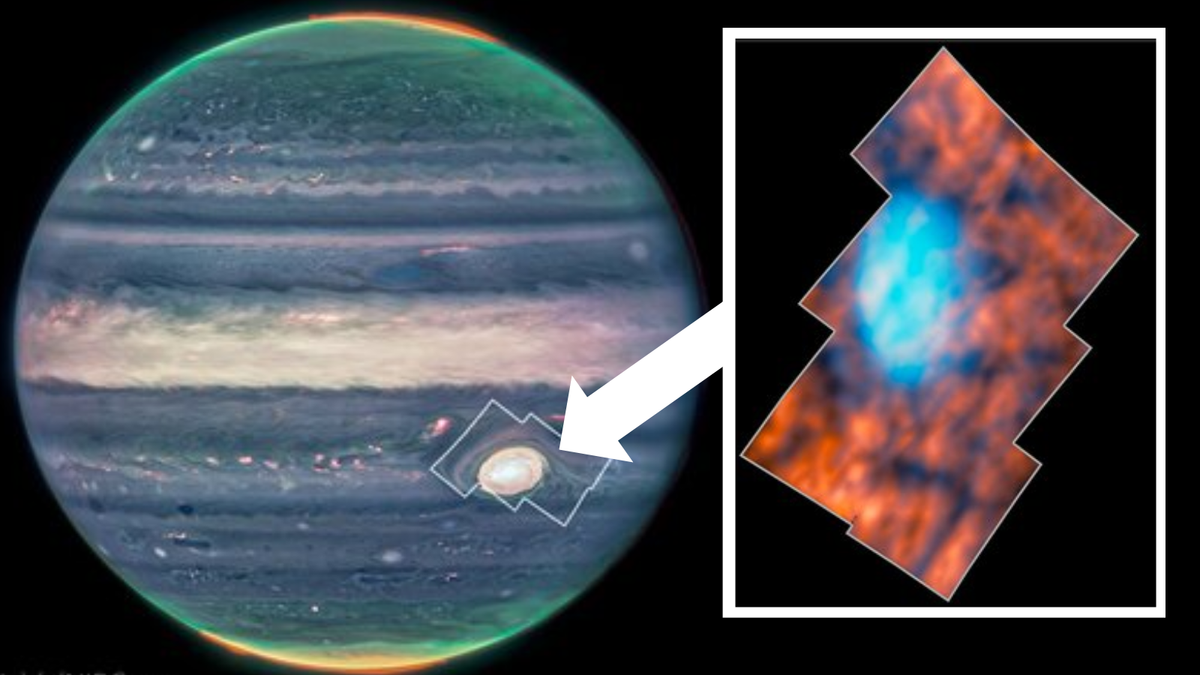Using the James Webb Space Telescope (JWST), astronomers have found previously invisible structures and activity in Jupiter’s atmosphere above the Great Red Spot. These strange features appear to be caused by powerful atmospheric gravitational waves.
The Great Red Spot is the largest storm in the solar system, twice the size of Earth, and has been raging for at least 300 years, according to NASA. The Great Red Spot’s winds rage at speeds of about 270 to 425 miles per hour (430 to 680 kilometers per hour), up to 3.5 times faster than a tornado here on Earth.
But despite the age, size and strength of the storm, scientists had actually suspected that Jupiter’s atmosphere above the Great Red Spot wasn’t all that interesting. However, these new observations from the JWST’s Near InfraRed Spectrograph (NIRSpec) instrument, which observed the massive Scarlet Storm in July 2022, show that this assumption could not have been more wrong.
Related: Is Jupiter’s Great Red Spot an impostor? The giant storm may not be the original storm discovered 350 years ago
“We thought, perhaps naively, that this region would be very boring,” team leader Henrik Melin of the University of Leicester said in a statement. “It’s actually just as interesting as the Northern Lights, if not more so. Jupiter continues to surprise.”
What secrets does the Great Red Spot hide?
Jupiter’s upper atmosphere is the point where the planet’s lower atmosphere meets its magnetic field. This leads to bright northern and southern lights, driven by bombardment of charged particles from the Sun and fueled by nebulae of volcanic material erupting from Jupiter’s moon Io, the most active volcanic body in the solar system.
Jupiter is possibly one of the brightest objects in the night sky above Earth and is easily seen in clear skies. Yet the atmosphere of the solar system’s largest planet glows only faintly, aside from the northern and southern lights, making it difficult for ground-based telescopes to see through Earth’s atmosphere in detail.
From JWST’s position, a million kilometers away from Earth, our planet’s atmosphere is no barrier to this $10 billion space telescope. In addition, the JWST’s sensitivity in the infrared spectrum allows it to see the gas giant’s atmosphere in great detail, including the region above the Great Red Spot.
To see if this region is a bit dull, Melin and colleagues zeroed in on it with NIRSpec, the JWST’s main instrument. This led to the discovery of a variety of intricate structures in the JWST’s field of view, including dark arcs and bright spots.
Although incoming sunlight is responsible for most of the light seen through Jupiter’s atmosphere, the team thinks there must be some other light causing changes in the shape and structure of Jupiter’s upper atmosphere.
“One way you can change this structure is through gravitational waves – similar to waves crashing onto a beach and creating ripples in the sand,” Melin explains. “These waves are generated deep in the turbulent lower atmosphere, around the Great Red Spot, and they can travel in height, changing the structure and emissions of the upper atmosphere.”
These gravitational waves are very different from gravity waves, the latter of which are small ripples in space and time, predicted by Albert Einstein in his 1915 general theory of relativity. Gravitational waves propagate through an atmosphere, unlike the fabric of spacetime as gravity waves do.
These atmospheric gravity waves are also occasionally observed on Earth, but these Earth-bound waves are much less intense and powerful than the same phenomenon occurring over Jupiter.
Related: Gravitational Waves vs Gravitational Waves: Know the Difference!
The team now hopes to follow up the detection of these newly found Great Red Spot features and the complex wave patterns that underlie them with the JWST. This future research could reveal how the waves flow through the gas giant’s upper atmosphere and how this causes the observed structures to move.
The findings are expected to help better understand the distribution of energy across Jupiter and support the European Space Agency’s (ESA) Jupiter Icy Moons Explorer (JUICE) mission.
JUICE was launched on April 14, 2023 and will reach Jupiter and its moons in 2031 when it will make detailed observations of Jupiter and its three large ocean moons, Ganymede, Callisto and Europa.
The team’s results are published in the journal Nature Astronomy.
